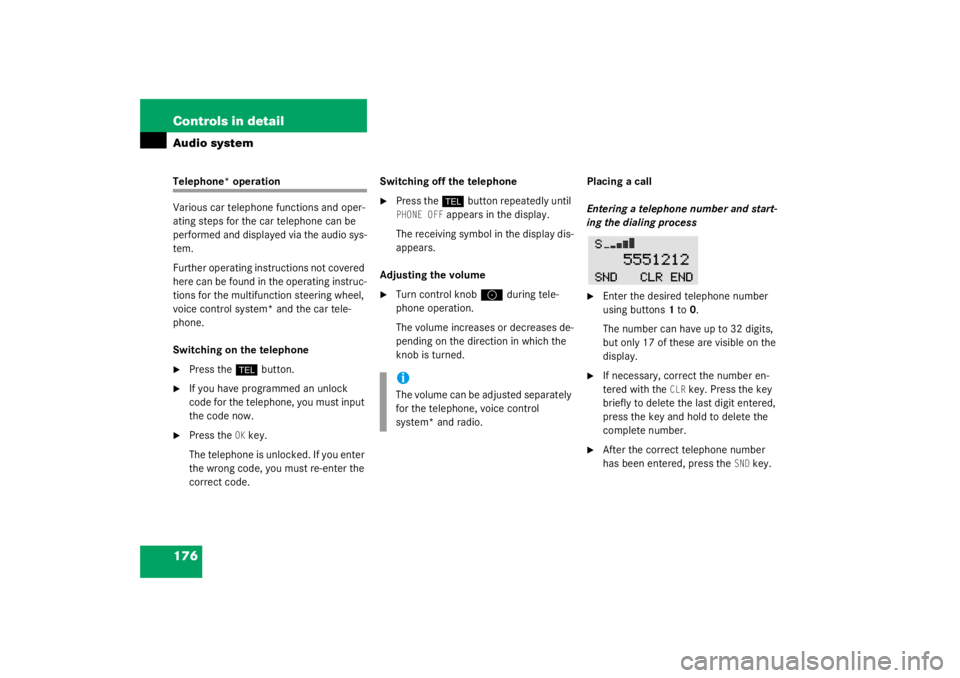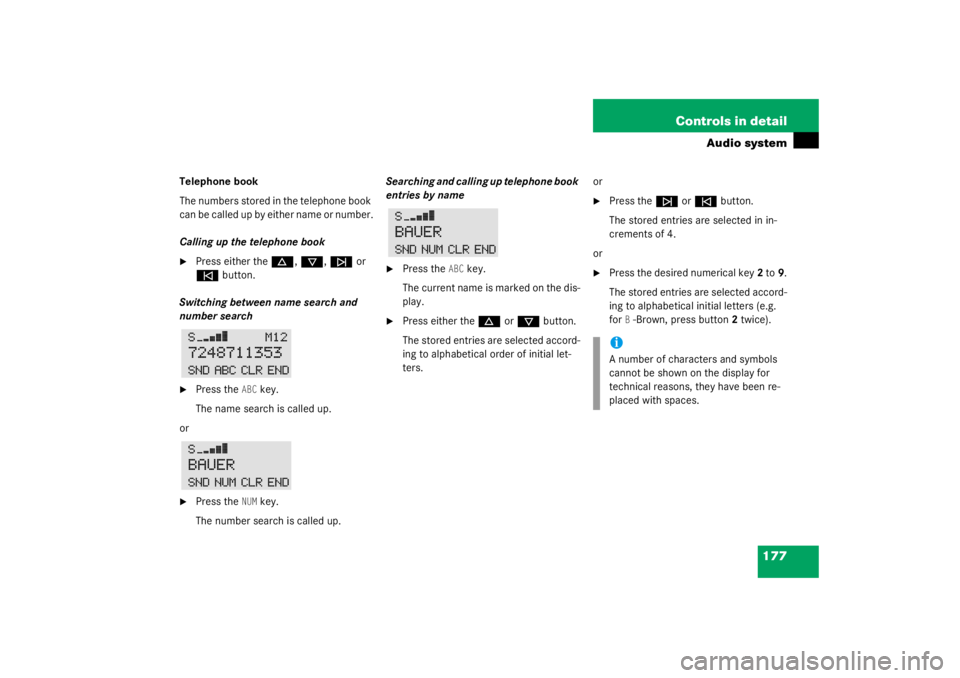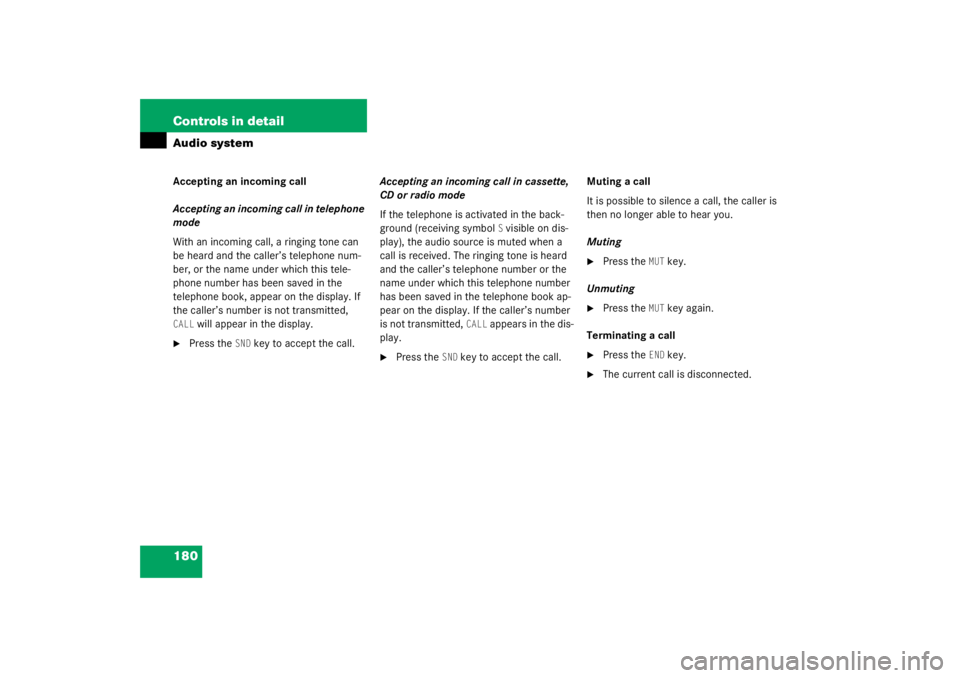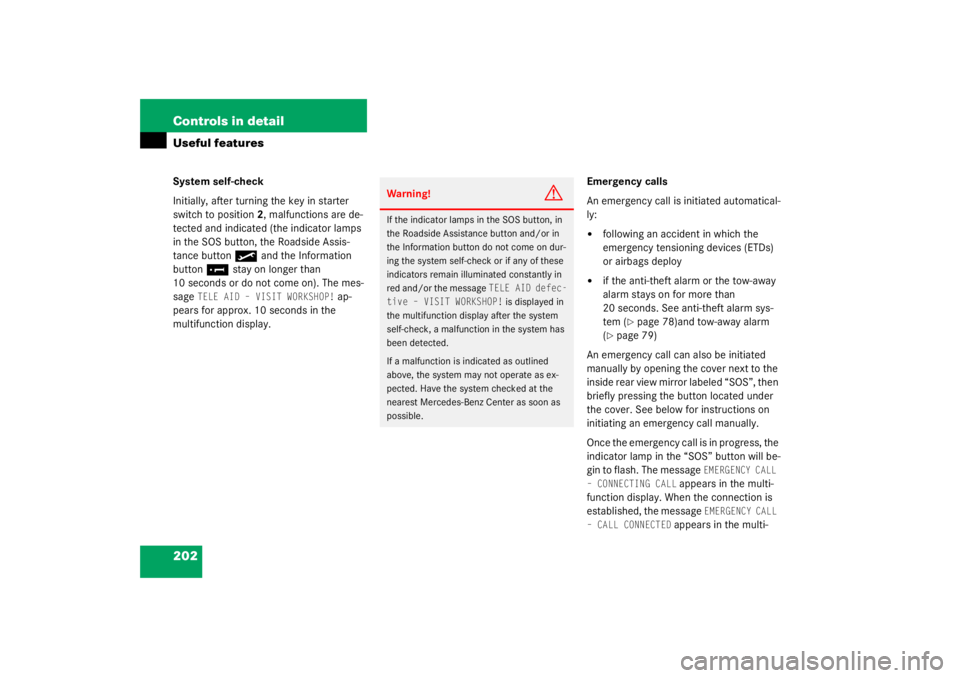Page 174 of 356
174 Controls in detailAudio systemSkipping tracks forward/backward
Skipping tracks forward:�
Press the
f
button.
The next track will be played.
Skipping tracks backward:
�
Press the
e
button.
If the track has been playing for more
than 10 seconds, it will revert to the
start of that track. If it has been playing
for less than 10 seconds, it will revert
to the preceding track.
Repeated pressing of the
f
or
e
button will result in multiple tracks being
skipped. Fast forward/reverse
Fast forward:
�
Press and hold the
d
button until
the desired location has been reached.
Reverse:
�
Press and hold the
c
button until
the desired location has been reached. Scanning
Starting scan:
�
Press the
2
button.
SC appears in the display.
Each track on the current CD will be
played for approx. 8 seconds in as-
cending order.
Ending scan:
�
Press the
2
button,
d
, c
,
f
or
e
button.
iThe relative time of the track is shown
on the display during search.
Page 175 of 356
175
Controls in detail
Audio system
Random play
The random play function (RDM) plays the
tracks on the current CD in random order.
Switching on random play:�
Press the
RDM
key.
RDM
appears on the display in in-
versed-color format.
Switching off random play:
�
Press the
RDM
key again.
The inversed-color
RDM
display disap-
pears. Repeat
The repeat function (RPT) repeats the cur-
rent track.
Switching on repeat:
�
Press the
RPT
key.
RPT
appears on the display in in-
versed-color format.
Switching off repeat:
�
Press the
RPT
key again.
The inversed-color
RPT
display disap-
pears. Track and time display
�
Press the
T key.
The number of the track being played
and the elapsed playing time appear in
the display.
�
Press the
T key again.
The total number of tracks and the total
playing time of the CD appear in the
display.
The CD main menu appears again after
8seconds.
iThe Random play and Repeat function
cannot be used simultaneously.
Page 176 of 356

176 Controls in detailAudio systemTelephone* operation
Various car telephone functions and oper-
ating steps for the car telephone can be
performed and displayed via the audio sys-
tem.
Further operating instructions not covered
here can be found in the operating instruc-
tions for the multifunction steering wheel,
voice control system* and the car tele-
phone.
Switching on the telephone�
Press the
h
button.
�
If you have programmed an unlock
code for the telephone, you must input
the code now.
�
Press the
OK key.
The telephone is unlocked. If you enter
the wrong code, you must re-enter the
correct code. Switching off the telephone
�
Press the
h
button repeatedly until
PHONE OFF
appears in the display.
The receiving symbol in the display dis-
appears.
Adjusting the volume
�
Turn control knob
a
during tele-
phone operation.
The volume increases or decreases de-
pending on the direction in which the
knob is turned. Placing a call
Entering a telephone number and start-
ing the dialing process
�
Enter the desired telephone number
using buttons
1 to 0.
The number can have up to 32 digits,
but only 17 of these are visible on the
display.
�
If necessary, correct the number en-
tered with the
CLR
key. Press the key
briefly to delete the last digit entered,
press the key and hold to delete the
complete number.
�
After the correct telephone number
has been entered, press the
SND
key.
iThe volume can be adjusted separately
for the telephone, voice control
system* and radio.
Page 177 of 356

177
Controls in detail
Audio system
Telephone book
The numbers stored in the telephone book
c a n b e c a l l e d u p b y e i t he r n a m e o r n u m b e r .
Calling up the telephone book�
Press either the
d
, c
, f
or
e
button.
Switching between name search and
number search
�
Press the
ABC
key.
The name search is called up.
or
�
Press the
NUM
key.
The number search is called up. Searching and calling up telephone book
entries by name
�
Press the
ABC
key.
The current name is marked on the dis-
play.
�
Press either the
d
or
c
button.
The stored entries are selected accord-
ing to alphabetical order of initial let-
ters. or
�
Press the
f
or
e
button.
The stored entries are selected in in-
crements of 4.
or
�
Press the desired numerical key 2 to 9.
The stored entries are selected accord-
ing to alphabetical initial letters (e.g.
for
B-Brown, press button 2 twice).
iA number of characters and symbols
cannot be shown on the display for
technical reasons, they have been re-
placed with spaces.
Page 178 of 356

178 Controls in detailAudio systemSearching and selecting telephone book
entries by number�
Press the
NUM
key.
The current number is marked in the
display.
�
Press either the
d
or
c
button.
The stored entries are selected accord-
ing to numerical order.
or
�
Press the
f
or
e
button.
The stored entries are selected in in-
crements of 4 (e.g. Entry M1, Entry
M5,
etc.).
Starting dialing process
�
Once you have selected a number,
press the
SND
key. Repeat dialing
If, for example, the number dialed is busy,
you can again place calls to the last 10
telephone numbers dialed using the repeat
dialing function.
Manual repeat dialing (redial)
�
Press the
SND
key.
The last number dialed is shown in the
display.
�
Select the desired telephone number
using the
d
, c
, f
or
e
button.
The abbreviation
L and the number of
the entry are shown in the top line of
the display.
�
When you have selected a number,
press the
SND
key.
The call will then be placed. Automatic repeat dialing (redial)
If a call cannot be connected, press the
SND
key.
REDIAL
will appear on the display and re-
peated attempts to place the call will be
made for the next 4 minutes.
Quick dialing
�
Enter the previously selected 3-digit
(1-999) number of the entry using the
number keys 1 to 0.
�
Press the
RCL
key.
The telephone number stored under
that entry will be dialed.
�
Press the
SND
key.
The call will be placed.
Page 179 of 356

179
Controls in detail
Audio system
Speed dialing�
Input the desired entry number using
the number keys
1 to 0.
A maximum of 2 digits can be entered.
If necessary, correct the last number
entered with the
CLR
key.
�
Press the
SND
key.
The telephone number stored under
that entry will be dialed. The number,
L
and the full entry number will be shown
in the display.
Express dialing
�
Press one of the desired number but-
tons 1 to 0 longer than one second.
The telephone number saved under
that number will be dialed. Emergency call
�
Press button
1 longer than one second.
�
A call will be placed to the saved num-
ber (e.g. 911).
You can make an emergency call to an
emergency rescue station with a mobile
communications network.
The emergency call will be placed as long
as the corresponding mobile communica-
tions network is available. To do this,
switch the telephone on if not already done
so.
The call will also be placed if the un-
lock-code is not entered. Emergency calls may not be possible with
all telephone networks or if certain net-
work services and/or telephone functions
are active. Check with your local network
operation company. It may take some time
to set up an emergency call.
To use this function you must ensure that
the number stored in memory location 1 is
the number to be dialed in case of emer-
gency.
If an emergency call cannot be connected,
the message
SYSTM BUSY
appears.
!Please be aware that button
1 might al-
ready be reserved for an emergency
call number.
!Please be aware that the 911 emergen-
cy call system is a public service. Using
it without due cause is a criminal of-
fense.
Page 180 of 356

180 Controls in detailAudio systemAccepting an incoming call
Accepting an incoming call in telephone
mode
With an incoming call, a ringing tone can
be heard and the caller’s telephone num-
ber, or the name under which this tele-
phone number has been saved in the
telephone book, appear on the display. If
the caller’s number is not transmitted, CALL
will appear in the display.
�
Press the
SND
key to accept the call.Accepting an incoming call in cassette,
CD or radio mode
If the telephone is activated in the back-
ground (receiving symbol
S visible on dis-
play), the audio source is muted when a
call is received. The ringing tone is heard
and the caller’s telephone number or the
name under which this telephone number
has been saved in the telephone book ap-
pear on the display. If the caller’s number
is not transmitted,
CALL
appears in the dis-
play.
�
Press the
SND
key to accept the call. Muting a call
It is possible to silence a call, the caller is
then no longer able to hear you.
Muting
�
Press the
MUT
key.
Unmuting
�
Press the
MUT
key again.
Terminating a call
�
Press the
END
key.
�
The current call is disconnected.
Page 202 of 356

202 Controls in detailUseful featuresSystem self-check
Initially, after turning the key in starter
switch to position2, malfunctions are de-
tected and indicated (the indicator lamps
in the SOS button, the Roadside Assis-
tance button
•
and the Information
button
¡
stay on longer than
10 seconds or do not come on). The mes-
sage
TELE AID – VISIT WORKSHOP!
ap-
pears for approx. 10 seconds in the
multifunction display. Emergency calls
An emergency call is initiated automatical-
ly:
�
following an accident in which the
emergency tensioning devices (ETDs)
or airbags deploy
�
if the anti-theft alarm or the tow-away
alarm stays on for more than
20 seconds. See anti-theft alarm sys-
tem (
�page 78)and tow-away alarm
(
�page 79)
An emergency call can also be initiated
manually by opening the cover next to the
inside rear view mirror labeled “SOS”, then
briefly pressing the button located under
the cover. See below for instructions on
initiating an emergency call manually.
Once the emergency call is in progress, the
indicator lamp in the “SOS” button will be-
gin to flash. The message
EMERGENCY CALL
– CONNECTING CALL
appears in the multi-
function display. When the connection is
established, the message
EMERGENCY CALL
– CALL CONNECTED
appears in the multi-
Warning!
G
If the indicator lamps in the SOS button, in
the Roadside Assistance button and/or in
the Information button do not come on dur-
ing the system self-check or if any of these
indicators remain illuminated constantly in
red and/or the message
TELE AID defec-
tive – VISIT WORKSHOP!
is displayed in
the multifunction display after the system
self-check, a malfunction in the system has
been detected.
If a malfunction is indicated as outlined
above, the system may not operate as ex-
pected. Have the system checked at the
nearest Mercedes-Benz Center as soon as
possible.